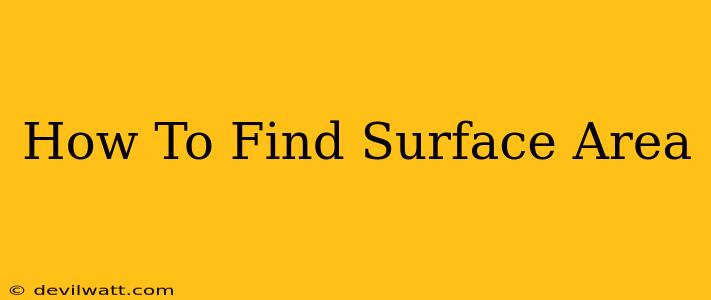Understanding how to find surface area is crucial in various fields, from architecture and engineering to packaging design and even baking! This comprehensive guide will walk you through calculating the surface area of different shapes, providing you with the formulas and practical examples you need. Whether you're a student tackling geometry problems or a professional needing to calculate surface area for a project, this guide will help you master this essential skill.
What is Surface Area?
Surface area refers to the total area of all the faces or surfaces of a three-dimensional object. Imagine you're wrapping a present – the amount of wrapping paper needed represents the surface area of the gift box. It's measured in square units, such as square centimeters (cm²), square meters (m²), or square feet (ft²).
Calculating Surface Area of Common Shapes
Let's delve into the formulas and calculations for some common 3D shapes:
1. Cube
A cube is a three-dimensional shape with six identical square faces.
Formula: Surface Area = 6 * side² (where 'side' is the length of one side)
Example: If a cube has a side length of 5 cm, its surface area is 6 * 5² = 150 cm².
2. Rectangular Prism (Cuboid)
A rectangular prism has six rectangular faces.
Formula: Surface Area = 2(lw + lh + wh) (where l = length, w = width, h = height)
Example: A rectangular prism with length = 4 cm, width = 3 cm, and height = 2 cm has a surface area of 2(43 + 42 + 3*2) = 52 cm².
3. Sphere
A sphere is a perfectly round three-dimensional object.
Formula: Surface Area = 4πr² (where r = radius)
Example: A sphere with a radius of 7 cm has a surface area of 4π(7²) ≈ 615.75 cm². Remember to use the value of π (approximately 3.14159) in your calculations.
4. Cylinder
A cylinder is a three-dimensional shape with two circular bases and a curved surface.
Formula: Surface Area = 2πr² + 2πrh (where r = radius, h = height)
Example: A cylinder with radius 3 cm and height 10 cm has a surface area of 2π(3)² + 2π(3)(10) ≈ 245.04 cm².
5. Cone
A cone is a three-dimensional shape with a circular base and a single vertex.
Formula: Surface Area = πr² + πrl (where r = radius, l = slant height)
Example: To find the surface area of a cone, you'll need both the radius and the slant height. If the radius is 4 cm and the slant height is 8 cm, the surface area is π(4)² + π(4)(8) ≈ 150.79 cm².
Tips for Accurate Calculations
- Use the correct units: Always include the units (cm², m², etc.) in your answer.
- Pay attention to the formula: Make sure you're using the correct formula for the shape you're working with.
- Double-check your calculations: It's easy to make mistakes with numbers, so always double-check your work.
- Use a calculator: Especially for shapes involving π, a calculator will make the calculations much faster and more accurate.
Beyond Basic Shapes
Calculating surface area for more complex shapes often involves breaking them down into simpler shapes whose surface areas you can calculate individually and then adding them together. This technique is often used in architectural and engineering designs.
Mastering Surface Area Calculations
Understanding how to find surface area is a fundamental skill with wide-ranging applications. By mastering the formulas and techniques outlined in this guide, you'll be well-equipped to tackle surface area problems in various contexts. Remember to practice regularly to build your proficiency and confidence!

